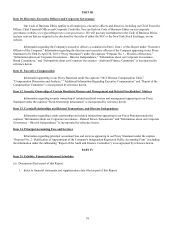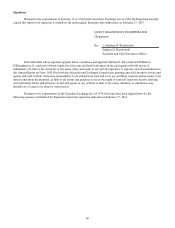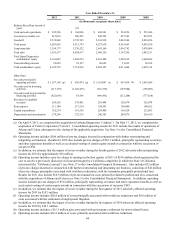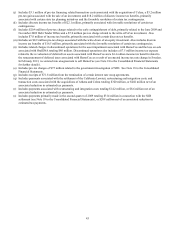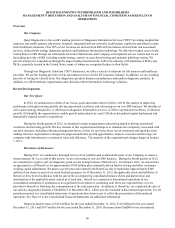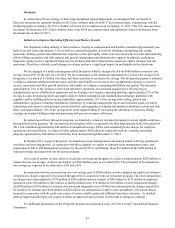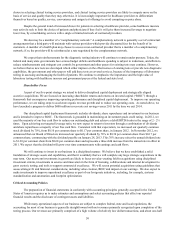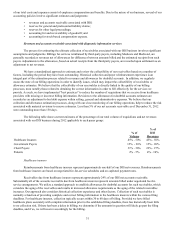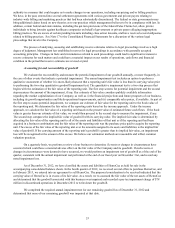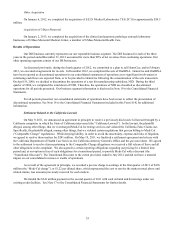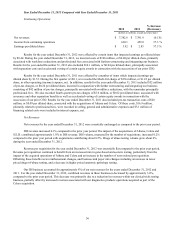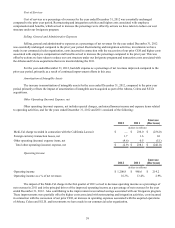Quest Diagnostics 2012 Annual Report Download - page 51
Download and view the complete annual report
Please find page 51 of the 2012 Quest Diagnostics annual report below. You can navigate through the pages in the report by either clicking on the pages listed below, or by using the keyword search tool below to find specific information within the annual report.48
The Company believes it has not grown at the level of the overall market, and as such has lost share. To accelerate
growth, the Company recently launched a multi-year initiative called Project Restore. Project Restore is designed to
complement the Invigorate program and will focus on identifying and implementing opportunities to drive profitable revenue
growth across the organization.
Diagnostic Information Services
Clinical testing is an essential element in the delivery of healthcare services. Physicians use clinical testing to assist in
detection, diagnosis, evaluation, monitoring and treatment of diseases and other medical conditions. Clinical testing is generally
categorized as clinical laboratory testing and anatomic pathology testing.
Most laboratory tests are performed by one of three types of laboratories: commercial clinical laboratories; hospital-
affiliated laboratories; or physician-office laboratories. In 2012, we estimate that hospital-affiliated laboratories accounted for
approximately 60% of testing performed outside the four walls of hospitals, commercial clinical laboratories approximately
one-third and physician-office laboratories the balance.
Orders for laboratory testing are generated from physician offices, hospitals and employers and can be affected by a
number of factors. For example, changes in the United States economy can affect the number of unemployed and uninsured,
and design changes in healthcare plans can affect the number of physician office and hospital visits, and can impact the
utilization of laboratory testing.
The diagnostic testing industry is subject to seasonal fluctuations in operating results and cash flows. Typically, testing
volume declines during the summer months, year-end holiday periods and other major holidays, reducing net revenues and
operating cash flows below annual averages. Testing volume is also subject to declines due to severe weather or other events,
which can deter patients from having testing performed and which can vary in duration and severity from year to year.
Key Trends
There are a number of key trends that we expect will have a significant impact on the DIS business in the United
States and on our business. In addition to the economic slow down in the United States which we believe has temporarily
reduced industry growth rates, these trends present both opportunities and risks. However, because clinical testing is an
essential healthcare service and because of certain of the key trends discussed below, we believe that the DIS industry will
continue to grow over the long term and that we are well positioned to benefit from the long-term growth expected in the
industry. The key trends that we expect will have a significant impact on the DIS business include:
• the growing and aging population;
• continuing research and development in the areas of genomics (the study of DNA, genes and chromosomes) and
proteomics (the analysis of individual proteins and collections of proteins), which is expected to yield new, more
sophisticated and specialized diagnostic tests;
• increasing recognition by consumers and payers of the value of laboratory testing as a means to improve health
and reduce the overall cost of healthcare through early detection and prevention;
• increasing affordability of, and access to, tests due to advances in technology and cost efficiencies;
• increasing focus to control the cost, utilization and delivery of healthcare services, including clinical testing, in a
highly competitive industry;
• increasing attention and government oversight of the healthcare industry;
• the growing demand for healthcare services in emerging markets and global demographic changes;
• increased strategic partnership opportunities with hospitals as they look to reduce costs and offset payer pressures
by outsourcing their existing laboratory testing; and
• the increased demand for our services as a result of health insurance coverage to uninsured Americans under the
Patient Protection and Affordable Care Act.
Healthcare Reform
In March 2010, U.S. federal legislation was enacted which is likely to have a significant impact on, among other
things, access to and the cost of healthcare in the United States. The legislation provides for extensive health insurance reforms
and expands coverage for approximately 32 million previously uninsured Americans, which will result in expanded access to
healthcare. In addition, the legislation eliminates patient cost-sharing for certain prevention and wellness benefits for health
insurance plans that are not “grandfathered.” We believe these changes will benefit our industry by leading to increased
utilization of our services.


